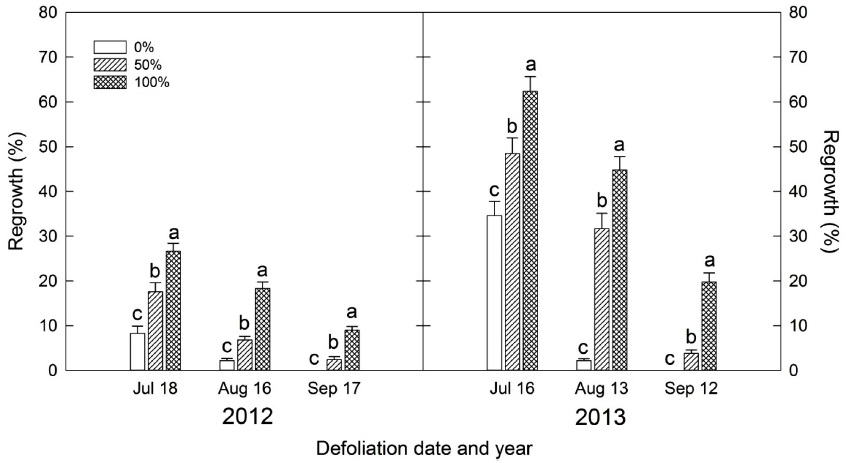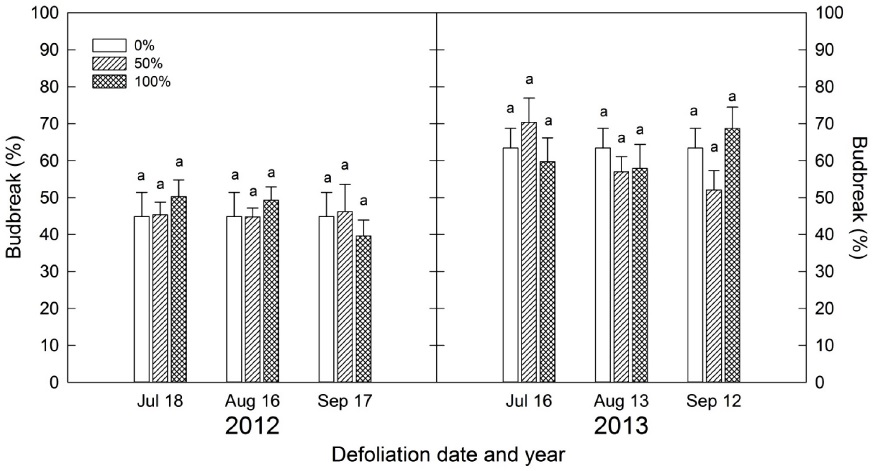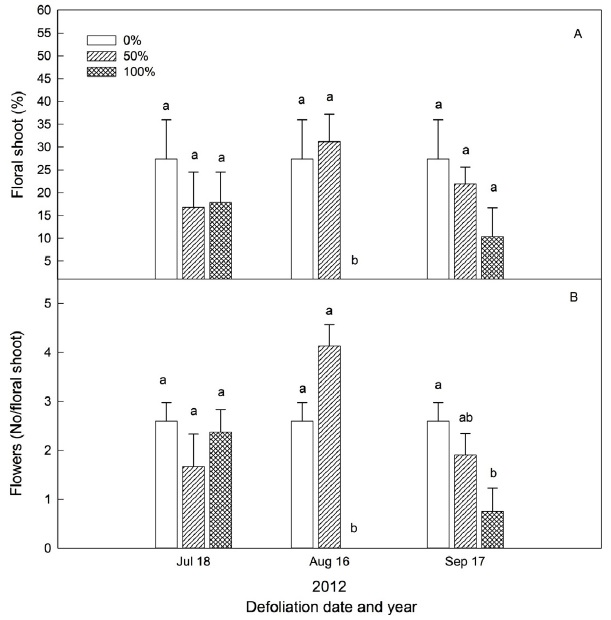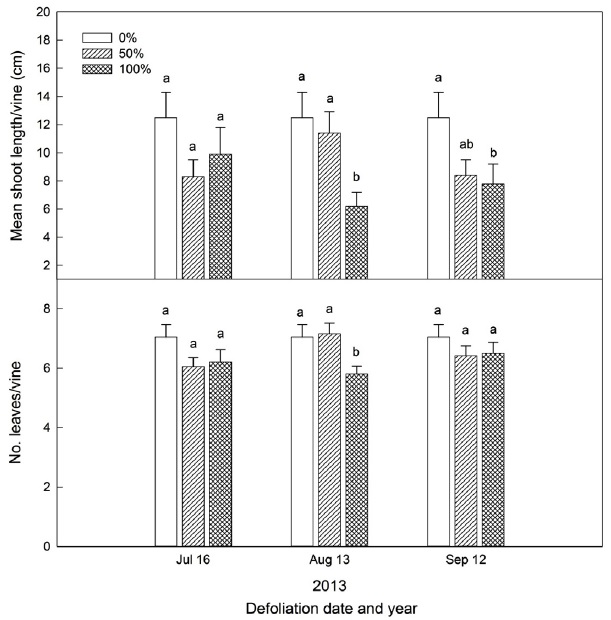



This study was conducted to investigate the effect of the unexpected early loss of leaves on a newly-bred kiwifruit on the regrowth of axillary buds the current season and the early growth and development the following year.
The vines were defoliated on Jul. 18, Aug. 16, and Sep. 17 in 2012 and on Jul. 16, Aug. 13, and Sep. 12 in 2013. The vines were defoliated 0 (control), 50, and 100% of the total number of leaves on a vine. The regrowth of axillary buds at 30 days after defoliation increased in proportion to defoliation degrees regardless of the defoliated time. Defoliation the previous season did not influence percent budbreak the next season. Percentage of floral shoots of the control vines was 27.4%, each bearing 2-3 flowers. In those vines defoliated 100% in August and September, however, percent floral shoots and number of flowers significantly reduced.
Defoliation in July, August, and September didnot affect percent budbreak the following year regardless of degrees of defoliation. A 100% defoliation in August and September significantly reduced flowering the following year compared to the control; that in August resulted in no floral buds at all.
국내 참다래재배와 생산의 중요한 제한요인중 하나인 바람, 특히 7-9월 태풍에 의한 조기낙엽은 당년 과실의 품질저하와 이듬해 개화량 감소를 유발하는 것으로 알려져 있다(농촌진흥청농업기술길잡이, 2014). 한반도에 직접적으로 영향을 미치는 태풍은 1년에 3개 정도이며, 주로 7-9월에 내습하고 있다(기상청태풍백서, 2011). 따라서 타과수에 비해 넓은 잎을 가진 참다래는 고품질과실을 생산하기 위해 파풍벽, 파풍망과 같은 바람 피해 대책을 실시하고 있다.
참다래의 눈발달은 여름 중반까지 거의 완료되어 가을에 휴면에 진입하며(Ferguson, 1990), 꽃은 이듬해 봄 신초의 잎겨드랑이에 착생한다(Brundell, 1975; Polito and Grant, 1984; Linsley-Noakes and Allan, 1987; Hopping, 1990; Snowball and Walton, 1992). 따라서 안정적인 참다래 과실생산을 위해서는 생육기간 중 액아의 재발아비율은 가능한 낮아야 한다.
태풍으로 인한 잎 피해는 저장양분 축적이 불량하여 복숭아(Kang and Ko, 1976), 사과(농촌진흥청 원예연구소 시험연구보고서, 2005) 등에서 이듬해 개화량 감소가 보고된 바 있다. Kwack 등(2013)에 의하면 참다래 ‘골드러쉬’ 무착과 유목은 7-9월의 인위적 낙엽으로 액아가 휴면에 들어가지 못해 재발아하는 현상이 발생하며, 이 시기의 100% 낙엽은 이듬해 결과지 비율이 무처리의 1/3 이하로 감소한다고 한다. 또한 7-9월의 50% 이상 낙엽은 무착과 참다래나무의 생장을 감소시켜 건물중이 무처리의 절반 이하로 감소하였으며, 8-9월 75% 이상 낙엽에 의해 뿌리의 전분축적이 무처리의 절반이하로 감소하는 것으로 보고되었다(Kwack
이러한 참다래나무의 조기낙엽 반응은 착과 유무에 따라 달라질 수 있을 것으로 보며, 특히 최근에 육성, 보급되고 있는 황색과육 신품종의 안정적 생산을 위해 이들 품종에 대한 조기낙엽에 관한 연구가 필요하다. 본 연구에서는 참다래 황색과육 신품종 착과 유목을 대상으로 한반도에 태풍이 영향을 미치는 7-9월의 조기낙엽이 당년의 눈발아와 익년 개화에 미치는 영향을 조사하였다.
공시품종은 농촌진흥청 국립원예특작과학원에서 육성되어 2012년 품종보호등록(제4111호)된 황색과육 신품종 ‘골드러쉬(Goldrush)’이었다. 포트 재배한 1-2년생 접목묘(
태풍에 의한 참다래나무의 낙엽은 엽병이 남은 상태로 잎 전체가 찢어져 탈락되는 양상이다. 따라서 본 실험에서는 태풍에 의한 낙엽피해를 재현하기 위해 전정가위를 이용하여 엽병을 남기고 잎을 제거하였다. 적엽처리는 한반도에 태풍이 주로 영향을 미치는 7, 8, 9월에 한달 간격으로 2012년(7월 18일, 8월 16일, 9월 17일)과 2013년(7월 16일, 8월 13일, 9월 12일)에 각각 실시하였다. 적엽정도는 각각의 적엽시기에 무처리(0%)를 두고 한 포트 전체 잎수를 조사한 후 그 잎의 50%와 100%를 제거하였다. 50% 적엽은 다자란 성엽을 기준으로 아래에서부터 교호로 전체 잎수의 절반을 제거하였다.
당년의 액아 재발아율은 적엽처리 30일 뒤에 한 나무의 모든 액아수와 이 중 발아된 수를 조사하여 산정하였다. 익년 발아율은 한 나무 전체 눈수와 이 중 발아된 수를 조사하여 산정하였는데, 2012년 적엽처리구는 2013년 4월 8일, 2013년 처리구는 2014년 4월 21일에 조사하였다. 결과지율과 결과지당착화수는 2012년 적엽처리에서만 조사하였다. 결과지율은 발아 30일 뒤에 발생된 신초 중 꽃봉오리가 있는 신초수의 비율을, 착화수는 이들 각각의 결과지(착화지)에 착생한 꽃수를 조사하여 산정하였다. 발아 후 30일간의 신초신장은 2013년적엽처리에서 조사하였는데, 2014년 4월 30일에 신초장과 엽수를 조사하여 전년 적엽에 따른 영향을 비교하였다.
본 실험의 처리는 완전임의배치 5반복으로 이루어졌으며, 조사된 데이터는 통계분석 패키지인 SAS 9.2, Enterprise 4.3(SAS Institute, Inc., Cary, N.C., USA)을 이용하여 분산분석과 던칸의 다중검정(
태풍에 의해 7-9월에 낙엽이 되면 그 정도에 따라 차이는 있지만, 보통 한 달뒤에는 액아의 생장을 확인할 수 있다(농촌진흥청 농업기술길잡이, 2014). 본 연구에서 조사한 적엽처리 30일 뒤의 액아 재발아율은 7, 8, 9월 3처리시기 모두 적엽수준간에 분명한 차이를 나타내어 적엽률이 증가할수록 높은 것으로 나타났다(Fig. 1). 시기적으로는 7월 중순 적엽처리에서 가장 높았고 9월 중순 적엽에서 가장 낮았다. 이는 ‘골드러쉬’ 무착과 유목의 경우 25-100% 적엽수준간에 재발아율의 차이가 없었던 것(Kwack
7월적엽 무처리구의 재발아율은 2012년과 2013년에 각각 8.3%, 34.6%를 나타냈지만, 8월과 9월 적엽 무처리는 각각 2.2%와 0%를 나타냈다(Fig. 1). ‘골드러쉬’ 무착과 유목의 경우 9월 15일에 조사한 무처리구의 재발아율이 약 5%였으나(Kwack
지난해 조기낙엽이 이듬해 발아율에 미치는 영향을 조사지난해 조기낙엽이 이듬해 발아율에 미치는 영향을 조사한 결과, 적엽시기와 수준에 관계없이 무처리(2013년 44.9%, 2014년 63.4%)와 비교해 차이를 나타내지 않았다(Fig. 2). 이는 ‘골드러쉬’ 무착과 유목을 대상으로 한 실험결과와 유사하나(Kwack
참다래의 생산성은 개화량에 의해 결정되기 때문에 신초의 수와 신초당 꽃수는 매우 중요하다(McPherson
낙엽과수는 이른 봄철 잎이 없거나 잎이 공급 부위로서의 기능을 충분히 수행하지 못하는 시기에 발아, 신초신장, 개화 등이 일어나는데, 이때 필요한 양분은 수체 영구기관, 특히 뿌리에 저장된 것으로부터 공급받는다(Titus and Kang, 1982; Tromp, 1983; Oliveira and Priestly, 1988; Loescher
이상의 결과로 볼 때, 골드키위 ‘골드러쉬’ 착과유목은 우리나라에 태풍이 주로 영향을 미치는 7, 8, 9월에 조기낙엽이 발생하면 적엽률이 증가할수록 액아의 재발아율이 증가함을 알 수 있었다(Fig. 1). 이와 같은 액아의 생육기 중후반 발아는 7월부터 발달중인 액아의 꽃눈 원기발달(Brundell, 1975; Hopping, 1990; Linsley-Noakes and Allan, 1987; Polito and Grant, 1984; Snowball and Walton, 1992)에 영향을 미쳐 이듬해 개화량을 감소시키는 것으로 보인다. 특히, 8월과 9월 중순의 100% 낙엽은 이듬해 개화량을 무처리의 절반이하로 감소시켜 생산량을 감소시킬 것으로 보인다. 이런 개화량 감소의 원인은 Kwack 등(2014)이 무착과 ‘골드러쉬’ 유목에서 보고한 것처럼 8, 9월의 75%이상 조기낙엽에 의해 수체에 비축된 전분, 가용성당이 무처리의 절반이하로 감소한 것과 무관하지 않은 것으로 보인다. 유사한 연구결과는 체리(McCamant, 1988), 복숭아(Lloyd and Couvillon, 1974), 피칸(Worley, 1979a, 1979b)등에서 보고 되고 있다. 따라서 착과수를 대상으로 조기낙엽에 따른 월동중 비구조탄수화물 축적연구가 추가적으로 필요하리라 보며, 생산농가에서는 바람에 대한 대비책을 강구하여 자연적인 낙엽기까지 잎을 온전히 보전하여 액아의 정상적인 발달과 수체내 비구조탄수화물 등의 저장양분 축적이 원활히 이루어지도록 해야 할 것이다.



